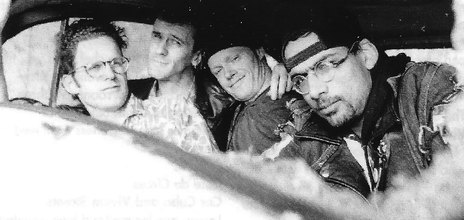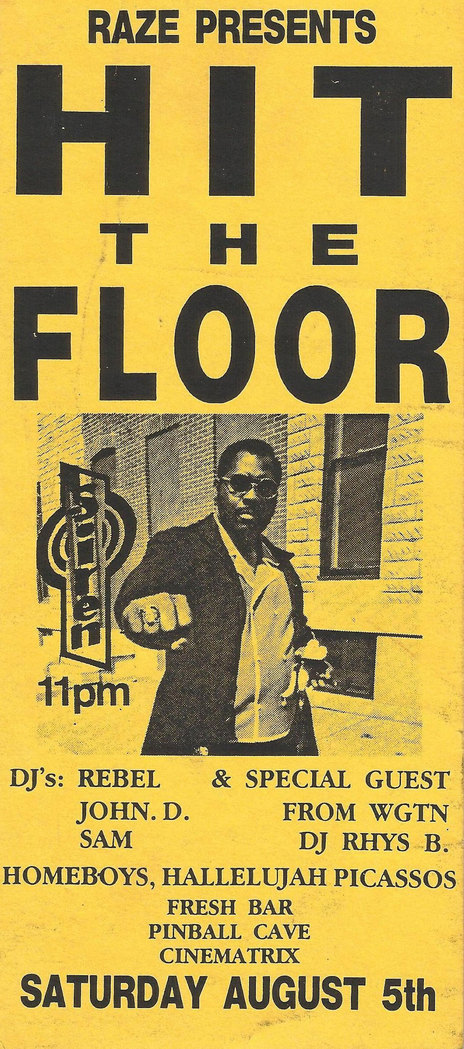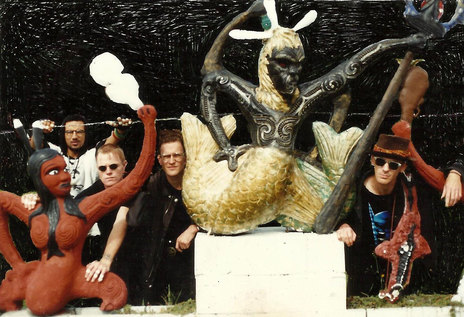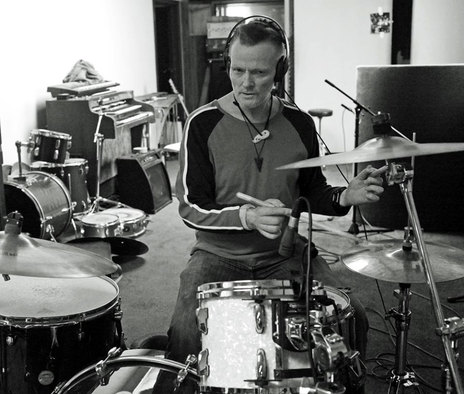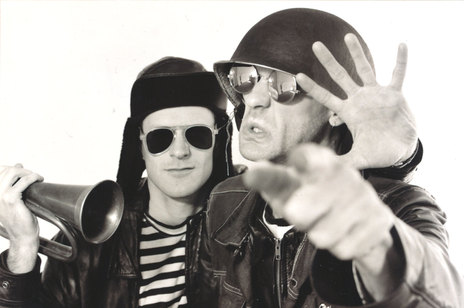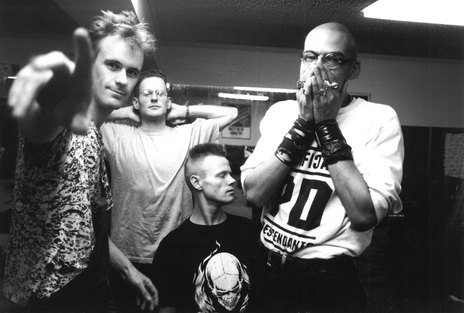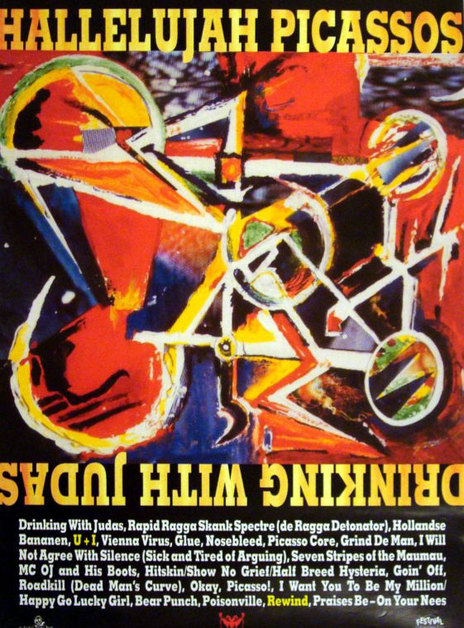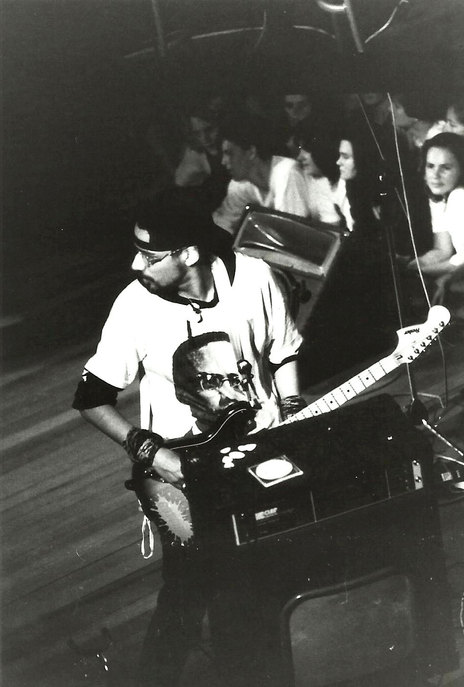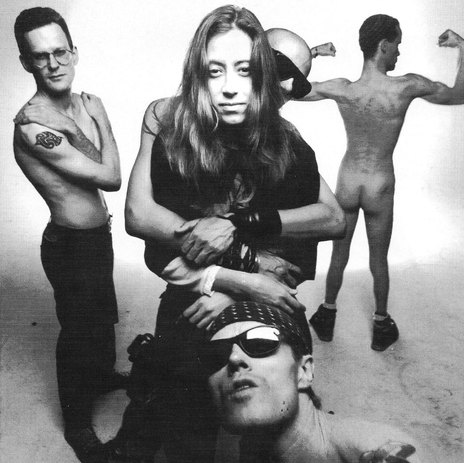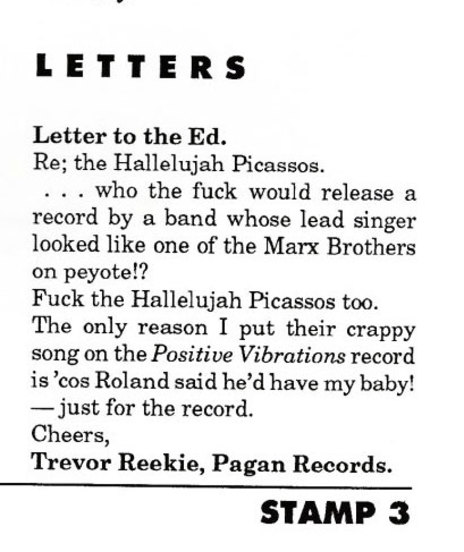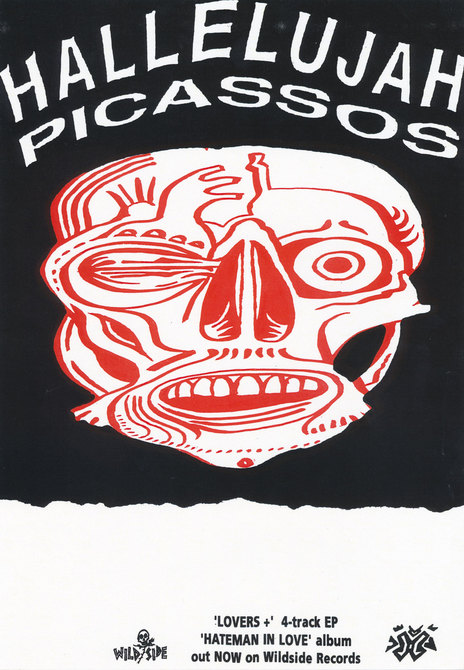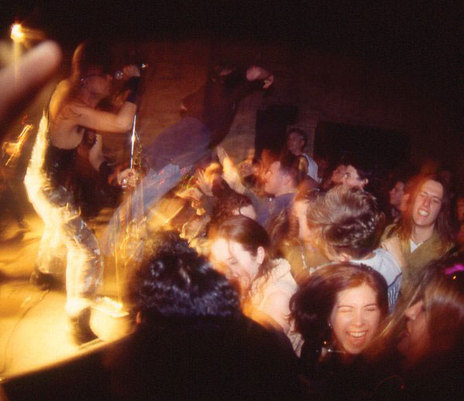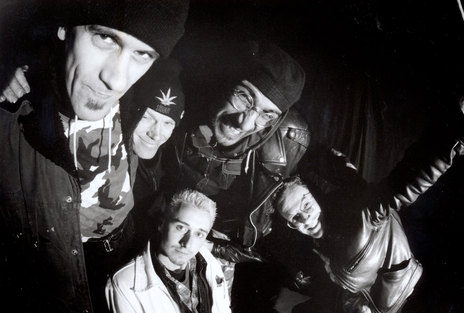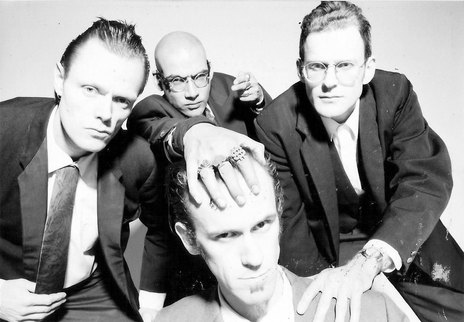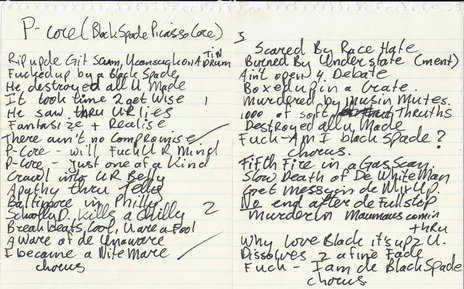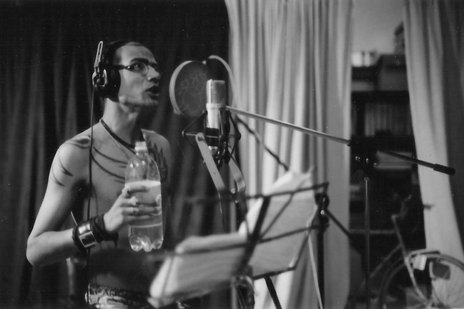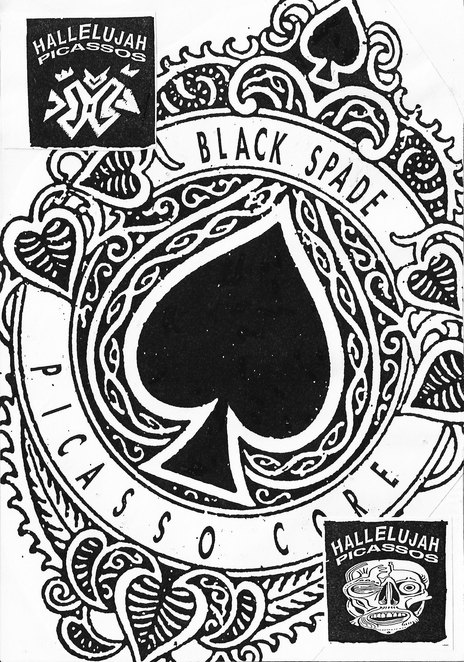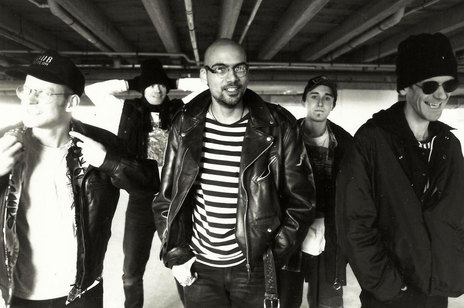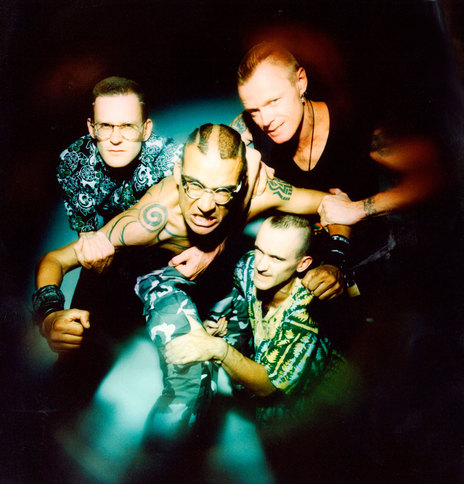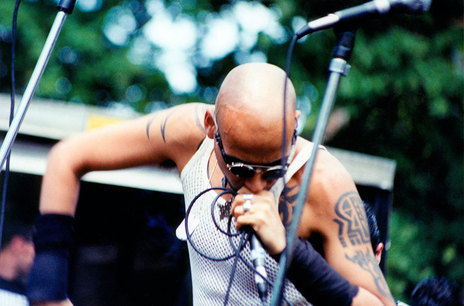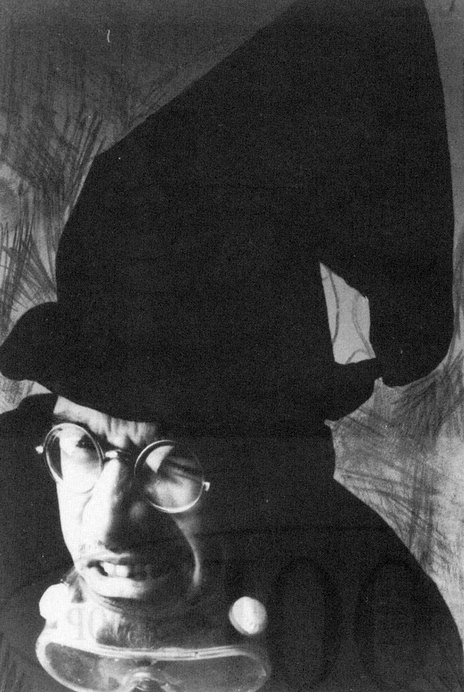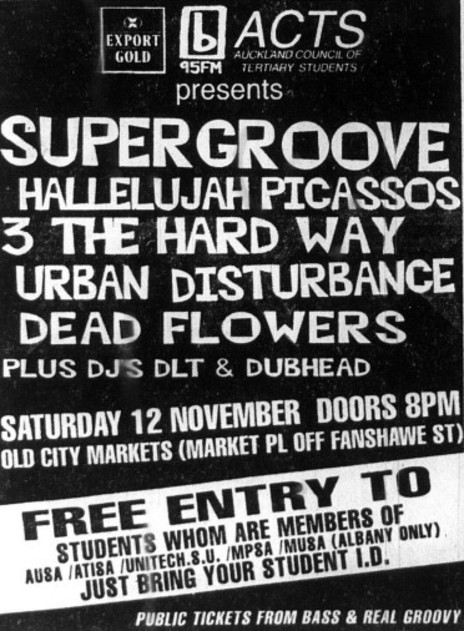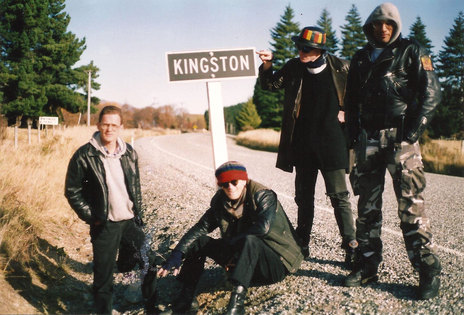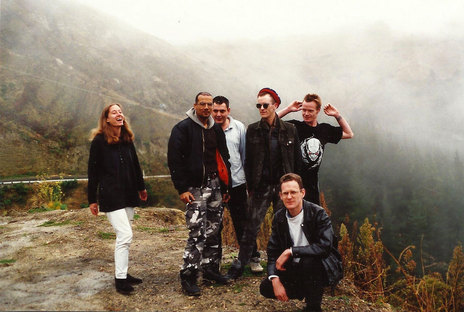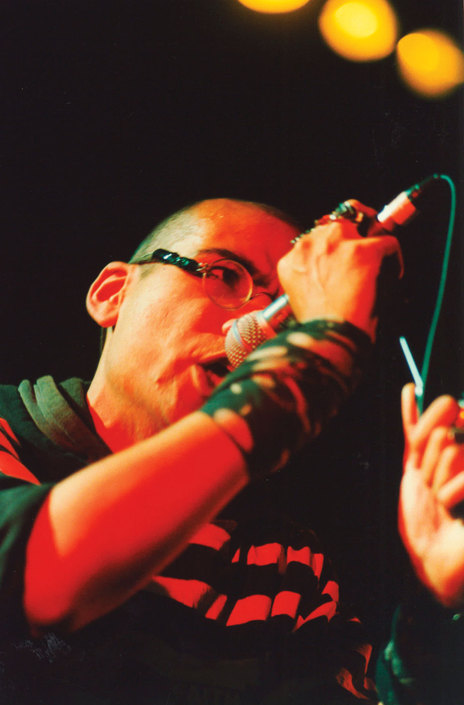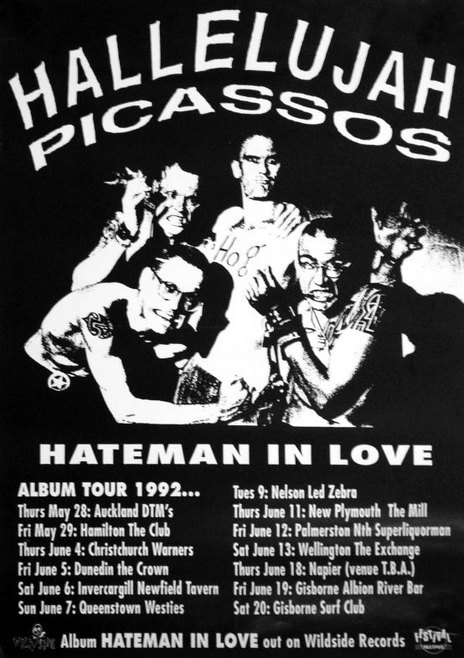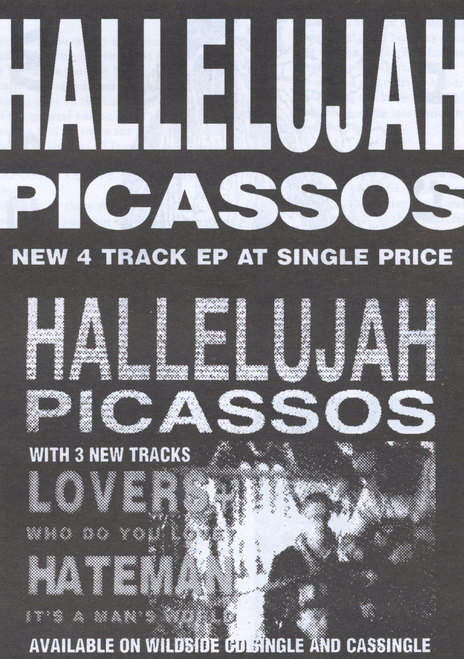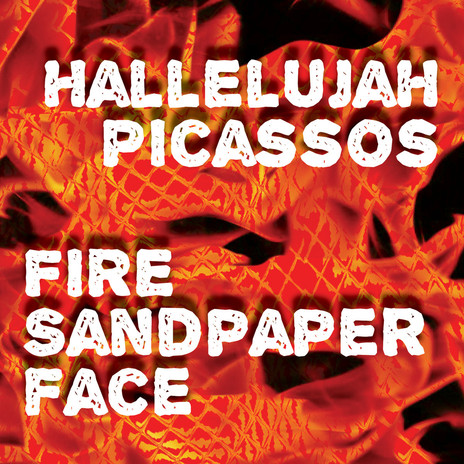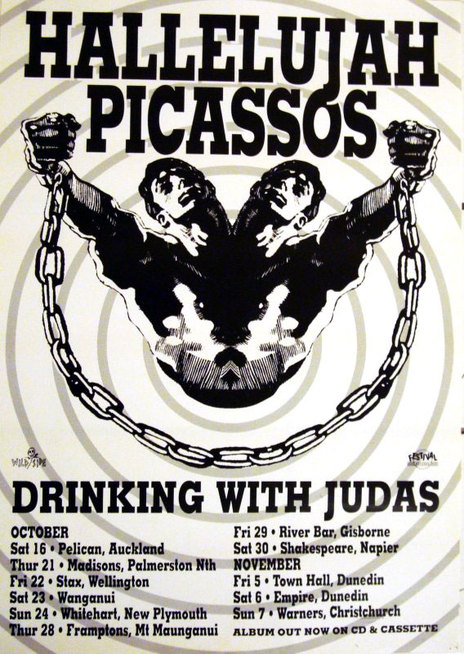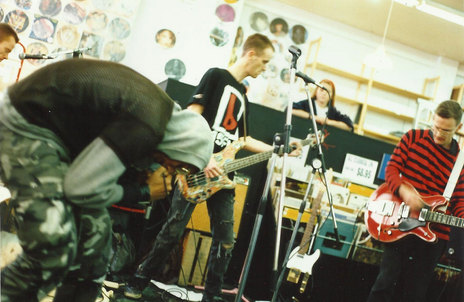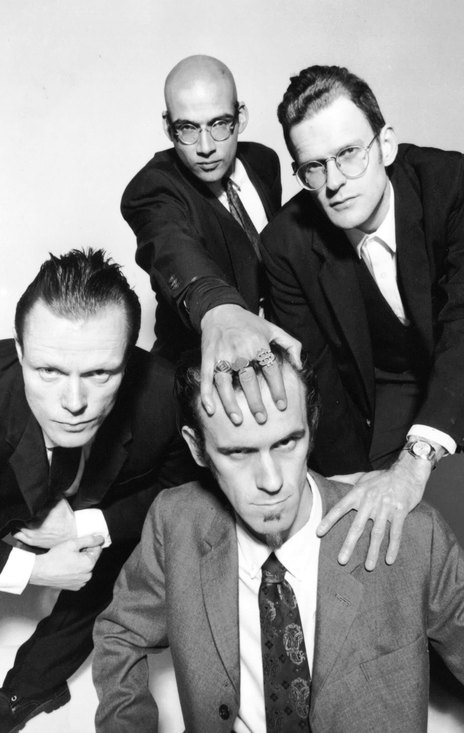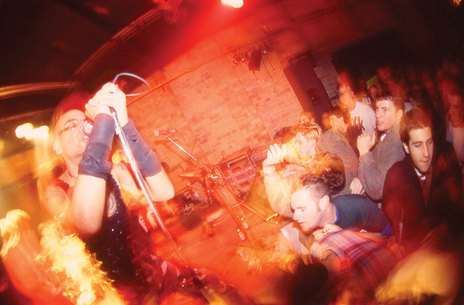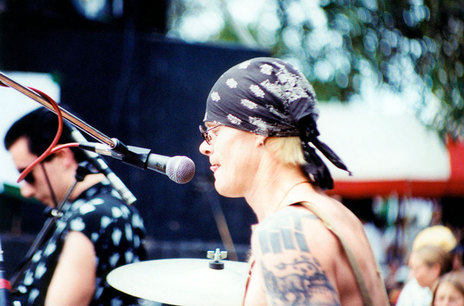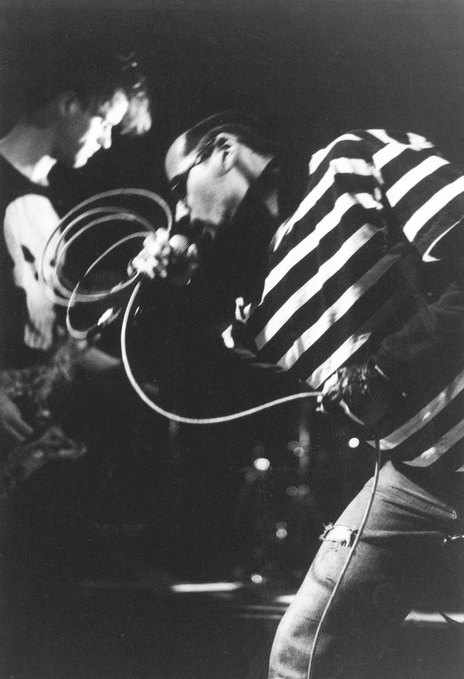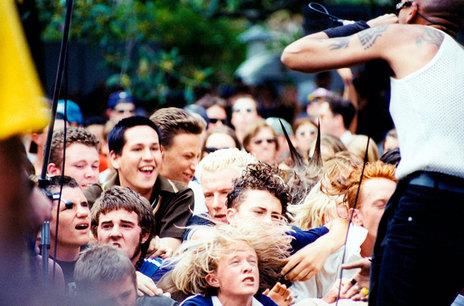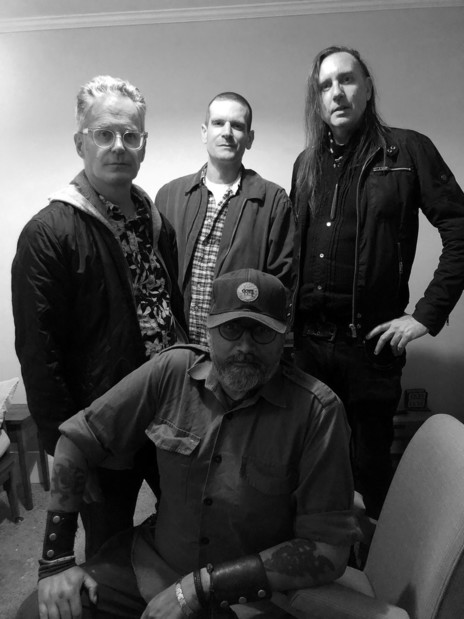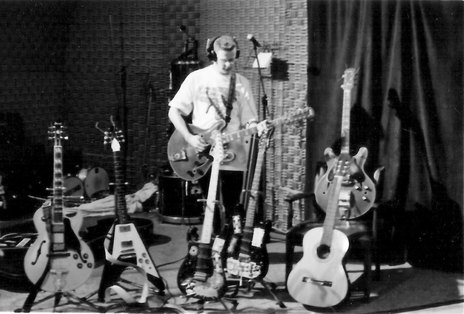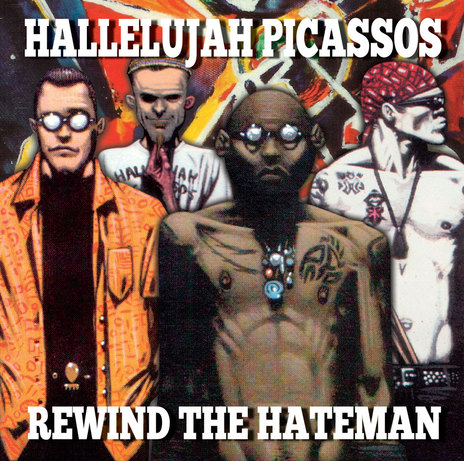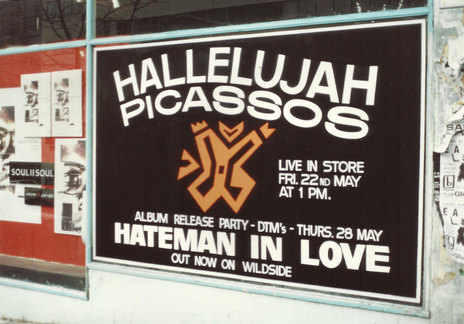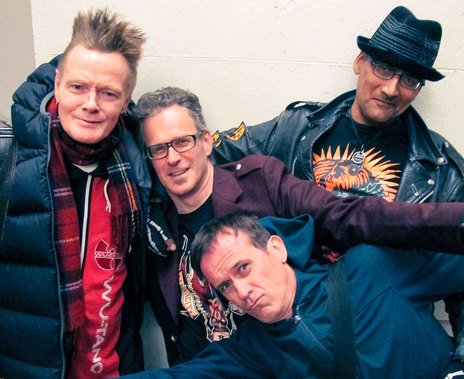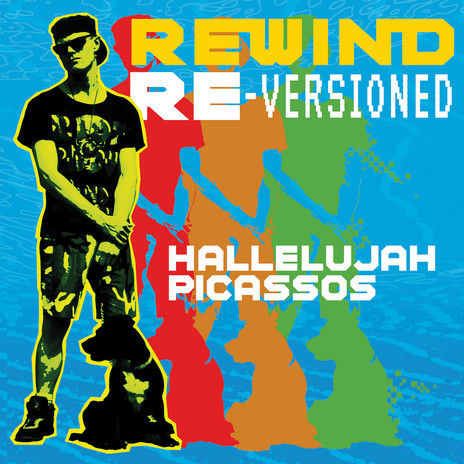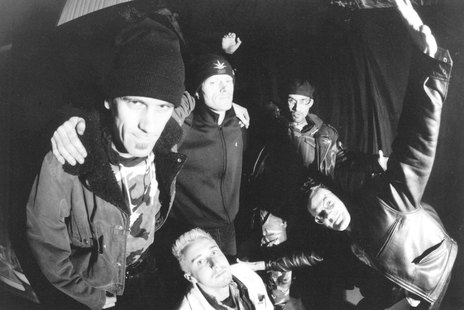But it was a struggle to push innovative music when New Zealand was still dominated by conservative music forces and eventually the band members lost heart for the struggle. The band returned with an out-of-the-blue re-mastered compilation release in 2011. And a couple of years later, they burst back onto the live scene, working to ensure their legacy would not be forgotten.
Hello Pablo
The story of the Picassos began when a young black Dutchman named Harold caught what turned out to be the final performance of industrial duo, Death Korporation, at a late night event as part of the Auckland Fringe Festival, held at DKD Cafe, where he worked.
Harold had moved to rural New Zealand when he was 17, but left for Auckland as soon as he had the chance. It was the band’s haphazard cover of James Brown’s ‘It’s A Man’s World’ that took his interest and he approached the guitarist Peter McLennan a few weeks later in a local nightclub, raving about how the cover had made his night after enduring a string of bad poets blathering on. They swapped numbers and started making music.
Their first attempt at music was a punky rockabilly outfit called The Rattlesnakes, formed in late 1987.
The pair could not have been more ill-matched – Peter already looking like the Elam Arts School student that he was and Harold – looking like a wiry street thug – but they hit it off. Their first attempt at music was a punky rockabilly outfit called The Rattlesnakes, formed in late 1987. When their drummer disappeared for a couple of weeks (it later turned out he was in jail), the pair enlisted a friend who Harold met through DKD. This was Bob – soon to be known as Bobbylon – a rugged looking character with a short buzzsaw mohawk.
Peter recalled that this roughshod line-up suited them at first: “We were a bass-less trio – me on guitar, Bobbylon on drums, Harold on vocals. We gigged like that for a while. We weren't too fussed with lack of a bass player, as we were taking our cues from The Cramps, who had two guitars and no bass.”
Yet they soon got sick of the restrictions of trying to stick to one genre and took a swerve into no man's land with their new outfit, Hallelujah Picassos. The word “hallelujah” was taken from a mock-gospel tune that they played called ‘Clap Your Hands’ and “Picassos” was picked off a list containing some of their favourite phrases. Harold also switched between names, listing himself as Roland Rorschach, Nightmare Stan, and King Harold at various times.
Things moved at pace after this. The band undertook a brutally long nine-hour day at Airforce Studios, recording 26 tracks live to tape and eventually putting out 12 of them for a self-released cassette, Taxi Driver (1989), along with two tracks recorded at the bFM studio. The band scored the recording time at Airforce after Harold/Roland and Bobbylon had worked there as labourers while the studio was being built, painting and plastering, and got paid in studio time.
Pagan Records picked up the song, ‘Clap Your Hands’ (off Taxi Driver) for their compilation (Positive Vibrations, 1989). This was enough to inspire the band-made music video, which cost the grand sum of $138, thanks to some free TVNZ film stock and editing time (courtesy of Mark Tierney). They decided against playing their own instruments onscreen and just jumped around on a stage set resembling a messy student flat – Peter holding an accordion,Harold/Roland holding a trumpet, and each of them taking turns at a piano. In an early scene, they drift around an empty railway station yard and Bobbylon is shown wearing a Bob Marley T-shirt – a hint of things to come. Harold/Roland and Bobbylon had already been trading reggae cassettes and this influence led the band to do an early demo of ‘Crack Dub’ – a creeping, reverb-crunching dub tune.
The last piece fell into place for the band when Johnnie Pain joined on bass guitar (taking over from Tony de Raad, later of David Kilgour and the Heavy Eights). Pain had already self-released some cassettes and done an EP with Flying Nun under the name Black Girls Machine (with former Crystal Zoom! guitarist Mike Weston), but his progress was stalled by a horrendous car crash. As he recovered, he was determined to get back into music:
“I had just bought a Roland sampler/sequencer and was gonna hide in my house and write a sample-based work of genius. Then I went and caught the Picassos at the Auckland Youth Theatre. It was the first time I had seen them with a clear head. Harold had a large carving knife taped to the end of his guitar and the four of them sounded wicked. I left that gig thinking – how do I get into this band? A week or two later Harold mentioned that Tony was probably leaving and asked if I wanted to join. It was more important to them to find someone on the same wavelength than it was to find a technically accomplished bassist. I’d only been a keyboard player up ‘til that point ...”
Lovers Plus
It is 1990. The Powerstation is home to glam bands playing five-bucks-for-five-bands events. Flying Nun is still in its ascendancy. Next will be grunge and funk metal. Plenty of trends to follow or avoid. No matter what you play, it’s very unlikely that any of your music will ever end up on commercial radio. The steadily rising unemployment rate gives rise to a feeling of us-versus-them – those lucky enough to be climbing up the financial ladder and those who’d had the ladder kicked away in front of them. The noisy aggression of the Picassos' music marks them as outsiders and now they push further out into the unknown by throwing more reggae into the mix.
Bobbylon’s voice is velvety on their reggae tunes, while Roland screams almost indecipherably on some tracks.
You’d think this wouldn’t be a shock since The Clash mixed punk and reggae right from the start and Bad Brains had already taken this mix to extremes of heaviness in the 1980s. The difference was that the Picassos stretched the extremes even further – Bobbylon’s voice is velvety on their reggae tunes, while Harold/Roland screams almost indecipherably on some tracks.
The audience slowly adapted to this wild juxtaposition, but even the rabid fans were thrown a curve-ball when the band self-released a novelty song about how much they like ‘Peanut Butter’ – a raggedy ska version of a track by garage punk act, One Way Streets (trainspotters may like to note: the release party for the single was held on the last night of Surge nightclub). This tune nonetheless followed their other singles to the top of bFM’s Top 10. The cassette also featured their noisy anthem, ‘Black Spade Picasso Core’, and an odd Flying-Nun-esque ballad called ‘Shivers Acapella’.
Their next releases were also reggae-influenced – a single (‘No More’/‘Marshall Law Dub’) released through Pagan Records and ‘Rockin Time’ off the Freak the Sheep (1991) compilation. The latter had been put together by the band’s manager, Lisa Van Der Aarde, who was a loyal advocate for the group and local music generally (as the host of bFM’s Freak the Sheep show). The band also began to rack up an impressive list of support slots, including opening for acts such as Violent Femmes, Screamin’ Jay Hawkins, Faith No More, Primus, African Head Charge, Beastie Boys and Ice T with Body Count.
When the Picassos’ debut album, Hateman in Love (1992), finally arrived, it showcased all of these styles and more. It was aggressive in places (‘Bastardiser’), dubbed out in others (‘Hello Pablo’), and elsewhere was almost ritualistic (‘The Snakesman’s Cry’).
It even came close to having a hit single – ‘Lovers+’ was a superbly catchy slice of ska, with Greg Johnson on trumpet and Alice Latham on sax. The music video received a good bit of rotation and the song dipped into the Top 50, though it dropped out again just as fast.
It was a weird time to be a genre-bending band. People kept calling the Picassos “crossover”, while others complained that the production by Mark Tierney (Strawpeople) was too clean for such a gritty live act. Peter McLennan rejects this last complaint outright: “We were music fans first, we collected albums, so we wanted to make albums. That's what we did in the studio – made studio recordings.”
Whatever the case, the band was now at the forefront of the Auckland music scene and had their tentacles spreading out across the country. No one was quite ready when they released their follow-up album the very next year.
I will not agree with silence
Drinking With Judas (1993) was the band’s sprawling masterpiece. Rather than the firm hand of Mark Tierney, this time the production chair was taken by the band along with K Rd poet David Hornblow (with Chris Sinclair engineering). Hornblow wasn’t just tolerant of their crazy ideas but travelled with them further into madness. No spaces were left between the songs, short interludes filled every sonic gap. All four band members had always contributed material for the band and now each of them had a chance to sing as well. There was even another novelty track (‘MC OJ and his Boots’, which is prefigured by OJ (Otis Frizzell) ranting about how he didn’t have anything to do with it).
The Picassos shared a practice room with Supergroove at the time, so their horn section turned up to play on ‘Nosebleed’. The Picassos even dipped into Afro-Cuban rhythms for the first single off the album, ‘U+I’. The album artwork was done by Johnnie Pain and rising comics star, Martin Emond (whose graphic novel, White Trash, went on to make him a cult figure in the USA). Emond drew each of the band members in all their individual glory – like cartoon characters. It seemed like the band were poised take over the country ... and yet ... and yet ...
A lot of listeners may have loved their mish-mash of styles, but the mainstream couldn’t handle them.
A lot of listeners may have loved their mish-mash of styles, but the mainstream couldn’t handle them. Reviews were either full of praise or full of advice – the Capital Times wrote “it’s just a pity that most of their records are so confused” while The Daily Post suggested that, while this album was interesting, “number three could be brilliant if the four refine their direction.”
The band toured endlessly but were slow to break new ground. They released another super-catchy reggae track, ‘Rewind’ in 1994 and again dipped into the national Top 50, while also topping bFM’s Top 10 for several weeks.
Meanwhile, each of the members was now well-known in their own right. Harold continued to be the city’s most recognisable barista (at DKD), Peter’s name appeared under articles in all the best local music mags (RipItUp, Stamp, Real Groove, NZ Musician and Pavement), and Johnnie was providing animations for weekly NZ music show Frenzy.
Even more impressive was Bobbylon’s sideline as a guest vocalist – his vocals can be heard on recordings by MC OJ & Rhythm Slave, Teremoana Rapley, and Maree Sheehan. He even provided the chorus for the hit track ‘Hip Hop Holiday’ by local rap act 3 The Hard Way. When it became a surprise hit on both sides of the Tasman, he disappeared briefly for tours of New Zealand and Australia.
The Picassos nonetheless remained in full force and even added a second guitarist – Gavin Downie (from the short-lived group Colony) – to free up Harold/Roland’s ability to focus on his singing.
Time kills
The Picassos' last release was an EP called The Gospel of the DNA Demon (1995). The lead single, ‘Smokin’ and Fumin’’ shows all the elements that both made the band great, and at the same time, held them back. The track bursts out with fuzzy guitars and pounding drums, before successive singers jump in, each taking the song somewhere different. The eight other tracks on the EP do nothing to bring the direction into focus, even wandering off into a 13-minute atmospheric jam (‘Snowcrash’) halfway through. The band funded their own video for the lead track, directed and produced by Peter McLennan, who had been closely involved in several of their previous videos.
As the band drew closer to a decade in existence, their energy began to flag, as Pain remembers: “By the end of things we seemed trapped in bouts of touring the country and playing the same places again, while CDs sent overseas solicited no response (a few years later when the ska-punk crossover broke out of the west coast of the USA it woulda been different). So perceived stresses, real and imagined, created a kinda pressure cooker. We were a big live drawcard with no commercial radio presence … frustrating. In hindsight, as mature adults, we realise we shoulda taken six months off and picked it up again when we felt like it. But we weren't equipped to respond like that back then, so we fell apart.”
Johnnie Pain and Peter McLennan left in quick succession at the end of 1995, citing “spiritual reasons.” Yet the band continued, with Bobbylon moving to bass and Harold/Roland picking up the guitar once more, while an ever-turning kaleidoscope of characters joined them onstage. The group released two last tracks on the Twentieth Century Animal (1997) compilation – ‘Rude Boy’ and ‘Yardie’ (though the latter had been recorded during the DNA Demon sessions with the previous line-up). But the balance between the four original members had been the key to keeping the outfit afloat and without this ballast, the ship began to keel over. By the end of 1996, Hallelujah Picassos were done.
Rewind the Hateman
Peter McLennan remained an active music journalist throughout his time with the Picassos and beyond. He also started his own project, Dub Asylum, which released many EPs and an album, She Dubs Me, She Dubs Me Not (2002) which featured both Bobbylon and Pain. By this stage, Johnnie Pain had simply become John and released music as painspeople (with a track on each of the Sideways compilations put out by Round Trip Mars and a 12-inch on Froth Records). Pain also did a spell as the bass player for the Nudie Suits and began creating music for animation artist, Jill Kennedy, before moving to Singapore and joining a local black metal band (Sanity Obscure). Bobbylon and Harold/Roland remained like ghosts around the central city.
Rewind the Hateman (2011) unearthed the group’s best tracks and got them back into the media again.
And then one day they came back to life. Rewind the Hateman (2011) unearthed the group’s best tracks and got them back into the media again. They followed this up with Picasso Core Jukebox (2012), which showcased the great range of cover versions the band had produced over their career. In the liner notes for Rewind The Hateman, Simon Grigg writes “their influence was undeniable, and a generation of local acts who refused to accept the boundaries that those Pink Floyd and Dire Straits-loving critics defined owe massively to the Picassos, often without realising exactly how much they broke down the barriers of musical conservatism in Auckland and beyond.”
Two years after Rewind the Hateman, Peter, Bobbylon and Harold/Roland took to the stage once more (supporting Drab Doo Riffs) with Darryn Harkness on bass.
A few months later and the reconstruction of the band was complete, with John Pain returning from Indonesia to take a new role, playing keyboard and dropping samples into the mix while David Hornblow manned the sound desk. Old fans joined new ones in bars across Auckland and the Picassos took a second chance to make the city their own.
In July 2014, the Picassos released their first single from the reformed band, 'Salvadore (Miles Away From You)'. Since then, the band has released a string of new tracks digitally and announced plans for a new album, to come out on vinyl and download for late 2018.
Bobbylon passed away on May 24th, 2018. In June 2019, the Picassos launched the album Voices of Exuberant Hellhounds with a show at Whammy and continue to release new recordings and play live.
In April 2023, the lineup was Roland Rorschach, Peter McLennan, Darryn Harkness and Drew McCormack.
In November 2025, Hallelujah Picassos released Rewind Re-versioned, a tribute to their late drummer Bobbylon. Released on the 30th Anniversary of the original 'Rewind', it features 20 remixes of the song, plus the original. Bobbylon sang the song from behind the kit.
